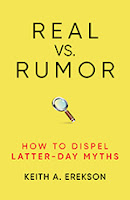On another blog, I’m continuing the series on the Real vs. Rumor book. It’s important because people should know how and why the narratives about Church history have been changes in recent years, and the tactics our scholars use to implement those changes.
Today we look at a few inexplicable errors. Tomorrow we’ll look at SITH specifically.
http://www.ldshistoricalnarratives.com/2022/05/real-vs-rumor-part-5-inexplicable-errors.html
_____
It’s all good to have multiple working hypotheses. People should be aware of the way both critics and apologists interpret the historical evidence. That helps people make informed decisions–provided they look at the actual evidence and not merely the spin provided by the critics and apologists.
A few decades ago, LDS scholars embraced a new approach to history that was developed in the secular world. The change was labeled “New Mormon History.” You can read a good summary on wikipedia:
https://en.wikipedia.org/wiki/New_Mormon_history
The New Mormon History has both positive and negative elements. Perhaps the most negative is the way the New Mormon Historians substituted a “new” consensus interpretation to replace the “old” consensus interpretation. Basically, they revised Church history in such as way as to undermine the credibility and reliability of Joseph Smith and Oliver Cowdery, particularly on the translation and historicity of the Book of Mormon, including Cumorah.
Because the Book of Mormon is the keystone of our religion, we’ll look more in upcoming days at the impact of the New Mormon History, which includes M2C and SITH.
Source: About Central America

